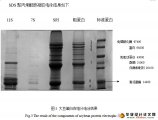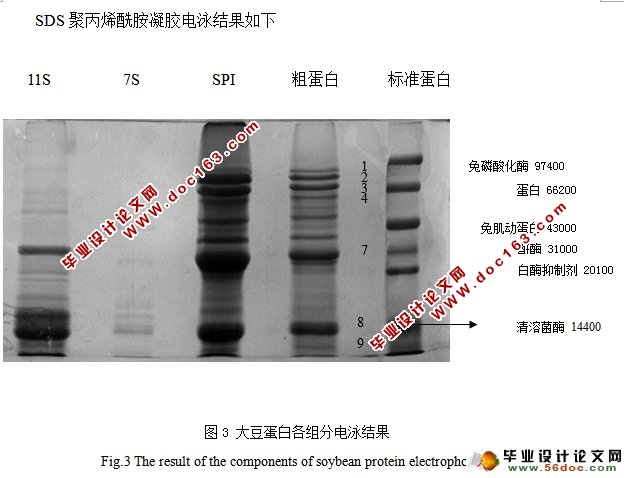大豆蛋白电泳分析

大豆蛋白电泳分析(选题审批表,任务书,开题报告,毕业论文13700字)
摘 要:大豆蛋白质,按照沉降模式,可分为2S、7S、11S和15S 4个主要的组分。本实验用碱提酸沉法和Thanh方法对大豆蛋白进行初步提取得到分离蛋白、7S球蛋白、11S球蛋白。然后利用考马斯亮蓝法测定大豆各组分蛋白的含量,再经SDS-PAGE电泳鉴定大豆蛋白各组分,并求出各组分亚基的相对分子质量。结果表明大豆蛋白总含量约占40%,粗提取得到的大豆分离蛋白约为86.6%左右,7S球蛋白约为75.6%,11S球蛋白约为80.25%。计算出的大豆各组分亚基的相对分子量与文献基本相吻合,为研究大豆蛋白功能特性提供了依据。
关键词:大豆蛋白;考马斯亮蓝法;碱提酸沉法;Thanh方法;分离蛋白;7S球蛋白;11S球蛋白;SDS-PAGE电泳
THE ANALYSIS OF ELECTROPHORESIS ON SOYBEAN PROTEIN
Abstract:Soy protein, in accordance with the settlement pattern, can be divided into 2S, 7S, 11S and 15S four major components. In this experiment, soy protein separation protein, 7S globulin, 11S globulin can be isolated initially by using alkali extraction and acid precipitation method and Thanh method. Using Coomassie brilliant blue method to calculate soybean protein content of each component, and then identifing soybean protein components by SDS-PAGE electrophoresis and calculating the molecular weight of subunits of each component , the results showed that the total soybean protein content is about 40%; the isolated soy protein is about 86.6% , 7S globulin is about 75.6%; 11S globulin is about 80.25%.The calculated soybean subunit molecular weight of each component basically consistent with the literature, the results provide a basis for a preliminary study of the soybean protein functional properties. [版权所有:http://DOC163.com]
Key words:Soybean protein;Coomassie brilliant blue method;alkali extraction and acid precipitation method;Thanh method; isolated soy protein ; 7S globulin; 11S globulin [资料来源:www.doc163.com]

目 录
摘要……………………………………………………………………………1
关键词…………………………………………………………………………1
1前言……………………………………………………………………………2
2材料与方法……………………………………………………………………8 [资料来源:https://www.doc163.com]
2.1 材料……………………………………………………………………………… 8
2.1.1 实验样品…………………………………………………………………8
2.1.2 主要试剂…………………………………………………………………8
2.1.3 主要仪器设备 …………………………………………………………8
2.2 方法………………………………………………………………………………9
2.2.1 试剂的制备………………………………………………………………9
2.2.2 碱提酸沉方法分离大豆分离蛋白………………………………………11
2.2.3 11S和7S球蛋白的的提取分离………………………………………12
2.2.4 考马斯亮蓝G-250法测定蛋白质含量………………………………13
2.2.5 SDS-PAGE电泳测大豆蛋白各组分的相对分子质量…………………14
3 结果与分析…………………………………………………………………………16
3.1 大豆蛋白含量测定………………………………………………………………16
3.2 大豆蛋白电泳…………………………………………………………………16
3.2.1 凝胶成像图显示…………………………………………………………16
3.2.2 统计与分析……………………………………………………………17
4讨论……………………………………………………………………………………19 [资料来源:www.doc163.com]
5 结论……………………………………………………………………………………19
参考文献 ………………………………………………………………………………20
致谢……………………………………………………………………………………21 [资料来源:www.doc163.com]
